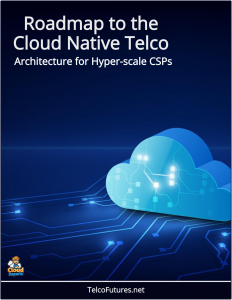What Does It Really Mean to Become a Cloud Native Telco?
Kailem Anderson from Blue Planet shares his experience in defining what capabilities are necessary and how critical OSS modernisation is to the journey.
 Cloud-native solutions refer to software applications, platforms, or systems specifically designed and built to operate in cloud computing environments, leveraging the inherent advantages of the cloud such as scalability, flexibility, and resilience.
Cloud-native solutions refer to software applications, platforms, or systems specifically designed and built to operate in cloud computing environments, leveraging the inherent advantages of the cloud such as scalability, flexibility, and resilience.
Unlike traditional software that might be adapted to run in the cloud, cloud-native solutions are architected from the ground up to exploit cloud principles and technologies, enabling organizations to maximize efficiency, agility, and innovation.
Cloud-native solutions are built to thrive in dynamic, distributed cloud environments—whether public, private, or hybrid—rather than relying on static, on-premises infrastructure.
The Cloud Native Computing Foundation (CNCF), a leading authority in this space, defines cloud-native technologies as those that “empower organizations to build and run scalable applications in modern, dynamic environments such as public, private, and hybrid clouds.” This involves a combination of architectural patterns, development practices, and operational methodologies optimized for the cloud.
Cloud-native solutions are distinguished by several core traits:
- Microservices Architecture: Instead of a monolithic, single-unit application, cloud-native solutions are broken into smaller, independent services (microservices). Each microservice focuses on a specific function (e.g., billing, authentication) and communicates with others via APIs. This modularity allows teams to develop, deploy, and scale individual components independently, improving agility and resilience.
- Containerization: Cloud-native applications are packaged into containers—lightweight, portable units that include the application code, dependencies, and runtime environment (e.g., using Docker or Kubernetes). Containers ensure consistency across development, testing, and production environments, and they can be easily moved or scaled across cloud infrastructure.
- Dynamic Orchestration: Tools like Kubernetes manage (or “orchestrate”) containers, automating deployment, scaling, and maintenance based on demand or failure. This enables self-healing systems that automatically recover from crashes and scale resources up or down as needed.
- DevOps and Continuous Delivery: Cloud-native solutions embrace DevOps practices, where development and operations teams collaborate closely, and CI/CD (Continuous Integration/Continuous Deployment) pipelines automate software updates. Frequent, low-risk updates reduce time-to-market and improve responsiveness to customer needs.
- Scalability and Elasticity: These solutions are designed to scale horizontally (adding more instances) rather than vertically (upgrading hardware), leveraging the cloud’s ability to provision resources on demand. Applications handle traffic spikes efficiently without over-provisioning resources during low-demand periods.
- Resilience and Fault Tolerance: Built with failure in mind, cloud-native systems use distributed architectures to ensure no single point of failure disrupts the entire application. Benefit: Downtime is minimized, and services remain available even if parts of the system fail.
- Cloud-Agnostic Design: While optimized for the cloud, many cloud-native solutions avoid tight coupling to a single provider (e.g., AWS, Azure), using open standards and APIs. This portability prevents vendor lock-in and supports hybrid or multi-cloud strategies.
Traditional (legacy) solutions, often monolithic and server-dependent, require manual scaling, have longer release cycles, and struggle with the flexibility of modern demands. Cloud-native solutions, by contrast, are purpose-built for the cloud’s distributed, on-demand nature, making them ideal for the AI era where speed, scalability, and data-driven insights are critical.
Cloud-native solutions represent a paradigm shift in software design, harnessing microservices, containers, orchestration, and DevOps to fully exploit cloud environments. They empower organizations—like the carriers partnering with Alianza—to modernize, innovate, and monetize their infrastructure efficiently, meeting the demands of an increasingly digital and AI-driven world.
Industry Experts
Has cloud native now entered the mainstream within telcos? Are we now seeing significant uptake in cloud-native infra and cloud-native function (CNF) workloads, and have internal software teams reorganised around cloud-native principles?
This panel explores the growth of cloud-native technologies and addresses key challenges, such as expertise gaps, operational complexities and vendor software maturity, while highlighting success stories in cloud-native telco deployments.
- Amajit Gupta, Group CEO & MD, Lightstorm Balaji Subramaniam, Director of Product Line Management, Blue Planet, a division of Ciena
- Juan Carlos Garcia, Senior Technology and Innovation Advisor, Independent
- Mark Longwell, Director, Telco and Edge Alliances, Hybrid Platforms Business Unit, Red Hat
- Partha Seetala, President, Cloud Business Unit, Rakuten Symphony



